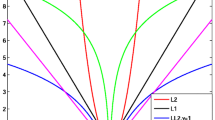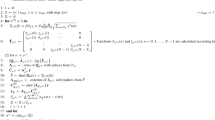Abstract
In this paper, we study the compressive sensing effects on 2D signals exhibiting sparsity in 2D DFT domain. A simple algorithm for reconstruction of randomly undersampled data is proposed. It is based on the analytically determined threshold that precisely separates signal and non-signal components in the 2D DFT domain. The algorithm operates fast in a single iteration providing the accurate signal reconstruction. In the situations that are not comprised by the analytic derivation and constrains, the algorithm is still efficient and need just a couple of iterations. The proposed solution shows promising results in ISAR imaging (simulated data are used), where the reconstruction is achieved even in the case when less than 10 % of data are available.








Similar content being viewed by others
References
D. Angelosante, G.B. Giannakis, E. Grossi, Compressed sensing of time-varying signals, in International Conference on Digital Signal Processing (2009), pp. 1–8
E. Candes, J. Romberg, T. Tao, Robust uncertainty principles: exact signal reconstruction from highly incomplete frequency information. IEEE Trans. Inf. Theory 52(2), 489–509 (2006)
D. Donoho, Compressed sensing. IEEE Trans. Inf. Theory 52(4), 1289–1306 (2006)
Q. Jiang, B. Guoan, X. Lv, ISAR maneuvering target imaging based on compressive time-frequency distribution, in 13th International Radar Symposium (IRS) (2012), pp. 430–434
H. Li, Y. Fu, Q. Zhang, R. Rong, A generalized hard thresholding pursuit algorithm. Circuits Syst. Signal Process. 33(4), 1313–1323 (2014)
C. Noviello, G. Fornaro, P. Braca, M. Martorella, ISAR motion compensation based on a new Doppler parameters estimation procedure, in IEEE International Symposium on Geoscience and Remote Sensing (IGARSS) (2015), pp. 2445–2448
L. Stankovic, I. Djurovic, T. Thayaparan, Separation of target rigid body and micro-Doppler effects in ISAR imaging. IEEE Trans. Aerosp. Electron. Syst. 42(4), 1496–1506 (2006)
L. Stankovic, I. Orovic, S. Stankovic, M. Amin, Compressive sensing based separation of non-stationary and stationary signals overlapping in time-frequency. IEEE Trans. Signal Process. 61(18), 4562–4572 (2013)
S. Stankovic, I. Orovic, M. Amin, L-statistics based modification of reconstruction algorithms for compressive sensing in the presence of impulse noise. Signal Process. 93(11), 2927–2931 (2013)
S. Stankovic, I. Orovic, L. Stankovic, An automated signal reconstruction method based on analysis of compressive sensed signals in noisy environment. Signal Process. 104, 43–50 (2014)
L. Stankovic, S. Stankovic, M. Amin, Missing samples analysis in signals for applications to L-estimation and compressive sensing. Signal Process. 94, 401–408 (2014)
J.A. Tropp, A.C. Gilbert, Signal recovery from random measurements via orthogonal matching pursuit. IEEE Trans. Inf. Theory 53(12), 4655–4666 (2007)
D. Vukobratovic, A. Pizurica, Compressed sensing using sparse adaptive measurements, in Symposium on Information Theory in the Benelux (SITB) 2014, Eindhoven (2014)
Y. Wang, Y. Jiang, Fourth-order complex-Lag PWVD for multicomponent signals with application in ISAR imaging of maneuvering targets. Circuits Syst. Signal Process. 29(3), 449–457 (2010)
X. Zhang, G. Liao, S. Zhu, D. Yang, W. Du, Efficient compressed sensing method for moving targets imaging by exploiting the geometry information of the defocused results. IEEE Geosci. Remote Sens. Lett. 12(3), 517–521 (2015)
Acknowledgments
This work is supported by the Montenegrin Ministry of Science, project grant funded by the World Bank loan: CS-ICT “New ICT Compressive sensing based trends applied to: multimedia, biomedicine and communications.”
Author information
Authors and Affiliations
Corresponding author
Rights and permissions
About this article
Cite this article
Stanković, S., Orović, I. An Approach to 2D Signals Recovering in Compressive Sensing Context. Circuits Syst Signal Process 36, 1700–1713 (2017). https://doi.org/10.1007/s00034-016-0366-8
Received:
Revised:
Accepted:
Published:
Issue Date:
DOI: https://doi.org/10.1007/s00034-016-0366-8




